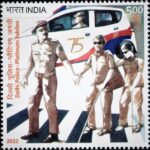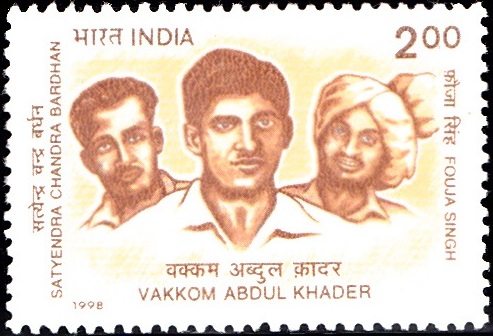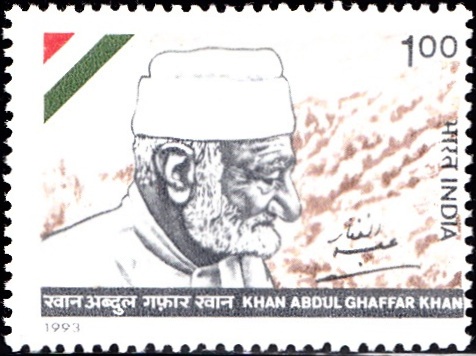
Solapur Martyrs
A commemorative postage stamp on 4 Martyrs of Sholapur, Maharashtra : Mallappa Dhanshetti, Shrikisan Sarada, Jagannath Shinde and Abdul Rasul Kurban Hussain :
 Issued by India
Issued by India
Issued on Oct 2, 2021
Issued for : Department of Posts is pleased to issue a Commemorative Postage Stamp on Mallappa Dhanshetti, Shrikisan Sarada, Jagannath Shinde and Abdul Rasul Kurban Hussain.
Credits :
Stamp/FDC/Brochure/Cancellation cachet : Smt. Alka Sharma
Type : Stamp, Mint Condition
Colour : Multi Colour
Denomination : 500 Paise
Stamps Printed : 302400
Printing Process : Wet Offset
Printer : Security Printing Press, Hyderabad
About :
- Mallappa Dhanshetti (1898-1931)
- Mallappa Dhanshetti was born in 1898. His ability to turn the stick was commendable. Dhanshetti was instrumental in bringing the common people of Solapur to the forefront of the freedom struggle. He was the first to be honoured in the procession of sticks set out during the fair of Shri Siddharmeshwar, it was an inspiration to the Shraddhananda community, Ganeshotsav and processions of Ganpati immersion. Rathyatra taken out by Shubhrai Math on Mahaekadashi saw his active participation in carrying them out peacefully and smoothly.
- Jagannath Shinde (1906-1931)
- Jagannath Shinde was a person with an indomitable will for independence, perseverance, confidence, fearlessness and zeal for accomplishment. He was born in 1906. He was mainly working in the Railway and Mill Workers Union. He was at the forefront of the labour movement. He worked hard to get more scholarships for the education of poor Maratha children. He had also participated in the Satyashodhak Parishad held in Mumbai.
- Abdul Rasul Kurban Hussain (1910-1931)
- Abdul Rasul Kurban Hussain was born into a family of frame makers. Lokmanya Tilak and Mahatma Gandhi were his inspiration. He was committed to the five principles: freedom, swadeshi, equality, socialism and Hindu-Muslim unity. He participated in rallies, marches and processions under the leadership of Dr. K. V. Antrolikars, his zeal for Hindu-Muslim unity was evident in his writings and speeches. Abdul Rasul Kurban Hussain was an iconic symbol of how a patriotic Muslim should be.
- Shrikisan Sarada (1893-1931)
- Shrikisan Sarada was a proud public figure, a person who generously helped in religious activities. He was born in 1893. His grandfather Govindrao Sarada came to Solapur for trade and settled there. On May 4, 1930, the British government arrested Mahatma Gandhi from Surat and he was sent to Yerawada Jail in Pune. As soon as the news of Gandhiji’s arrest was reported in the newspapers on May 5, the people staged a strike, a procession and a public meeting to protest against the government. On May 7, 18,000 mill workers went on strike. The people of Solapur staged a huge protest procession.
- As the procession approached the Bali gate, a crowd in the procession went to the Rupabhavani temple. There they peacefully cut down shindi trees and symbolically protested against the British government. At that time, the British police inhumanely beat eight members of the crowd and threw them into a police vehicle. Collector Knight and D.S.P. Flair got there. Collector Knight pulled out a pistol and go out of the car. As soon as Mallappa Dhanshetti realized this, he rushed there and calmed the crowd for a while and saved their lives. A request to release the eight people who were arrested by the police at that time was raised.
- While the discussion was going on, Shankar Shivdare, an 18 years old boy, approached the Collector with a tricolor flag in his hand. He was shot dead by a sergeant near the Collector. The crowd dispersed. The frightened Collector Knight picked up the names of the eight and released them. However, three more people were killed in the indiscriminate firing by the police and the crowd dispersed and marched on the nearby Peth police station on Tuesday. The police post was set on fire.
- Mallappa Dhanshetti, outraged by the conservative remarks about the citizens, ran over the Collector and grabbed a chair to kill him. So Collector Knight was holding a duke on them. As Shrikisan Sarada, a friend of Mallappa Dhanshetti, was financing the freedom movement, Collector Knight was furious with Sarada. All the youths were behind Jagannath Shinde who was a great organizer. Shinde’s involvement in the freedom movement was very much in the eyes of Collector Knight. Abdul Rasul Kurban Hussain was using the labour movement to fight for independence. Hindu-Muslim unity was being brought about through his weekly ‘Gajanfar’. The leases of the British monarchy were being removed. That is why Abdul Rasul Kurban Hussain was on the radar of Collector Knight. He planned to teach all four of them a lesson.
- Collector Knight deliberately fabricated evidence against Dhanshetti, Shinde, Sarada and Kurban Hussain in connection with the deaths of two policemen in an unidentified mob attack. Twelve false witnesses stood. During the trial, Judge Wadia did not allow the accused party to cross-examine the witnesses and did not allow any of the accused to cross-examine the witnesses. The lawsuit was just farce.
- It was decided to execute all the four. On June 6, 1930 all four were sentenced to death. The case was settled within a month of the incident. A week before the verdict was announced, Collector Knight had written a letter to his superiors seeking permission to hang the accused in a public place to intimidate the citizens. The four patriots were hanged on January 12, 1931. It was first day of the local fair of Siddharameshwar Temple. The British administration chose the day with a vicious intention of insulting the local people and making them learn a lasting lesson.
- It is a fact that India acquired freedom by virtue of the sacrifices of thousands of those revolutionaries.
- Text : Based on information received from the proponent.
Subscribe
Login
0 Comments
Oldest







